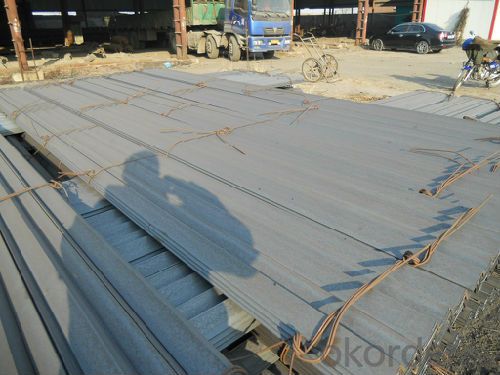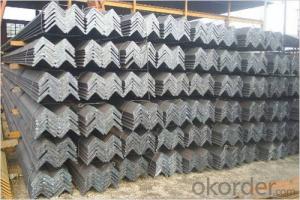Equal Angle Steel Hot rolled JIS G3101 SS400 Mild Steel Angle Iron
- Loading Port:
- Tianjin
- Payment Terms:
- TT or LC
- Min Order Qty:
- 29 m.t.
- Supply Capability:
- 30000 m.t./month
OKorder Service Pledge
OKorder Financial Service
You Might Also Like
Product Description:
OKorder is offering Equal Angle Steel Hot rolled JIS G3101 SS400 Mild Steel Angle Iron at great prices with worldwide shipping. Our supplier is a world-class manufacturer of steel, with our products utilized the world over. OKorder annually supplies products to European, North American and Asian markets. We provide quotations within 24 hours of receiving an inquiry and guarantee competitive prices.
Product Applications:
Equal Angle Steel Hot rolled JIS G3101 SS400 Mild Steel Angle Iron are ideal for structural applications and are widely used in the construction of buildings and bridges, and the manufacturing, petrochemical, and transportation industries.
Product Advantages:
OKorder's Equal Angle Steel Hot rolled JIS G3101 SS400 Mild Steel Angle Iron are durable, strong, and resist corrosion.
Main Product Features:
· Premium quality
· Prompt delivery & seaworthy packing (30 days after receiving deposit)
· Corrosion resistance
· Can be recycled and reused
· Mill test certification
· Professional Service
· Competitive pricing
Product Specifications:
Mild Angle steel
Grade : JIS G3101,SS400/SS540
Size: 25*25--250*250mm
Packing : bulk or container
Delivery time within 25 days .
equal angle steel | unequal angle steel |
specification(mm) | specification(mm) |
25*3/4 | 32*20*3/4 |
30*3/4 | 40*25*3/45*28*3/4 |
40*3/4/5 | 56*36*3/4/5 |
45*3/4/5/6 | 63*40*4/5/6/7 |
50*3/4/5/6 | 70*45*4/5/6/7 |
56*3/4/5/8 | 75*50*5/6/8/10 |
63*4/5/6/8/10 | 80*50*5/6/7/8 |
65*6/7/8/9 | 90*56*5/6/7/8/ |
70*4/5/6/7/8 | 100*63*6/7/8/10 |
75*5/6/7/8/10 | 100*75*6/7/8/9/10/12 |
80*5/6/7/8/10 | 100*80*6/7/8/10 |
90*6/7/8/10/12 | 110*70*6/7/8/10 |
100*6/7/8/10/12/14/16 | 125*75*7/8/9/10/12 |
110*7/8/10/12/14 | 125*80*7/8/10/12 |
120*8/9/10/12 | 140*90*8/10/12/14 |
125*8/10/12/14 | 150*90*9/10/12/15 |
130*9/10/12/13/15 | 150*100*9/12/15 |
140*10/12/14/16 | 160*100*10/12/14/16 |
150*12/15/19 | 180*110*10/12/14/16 |
160*10/12/14/16 | 200*125*12/14/16/18 |
175*12/15 | |
180*12/14/16/18 | |
200*14/16/18/20/24 | |
250*25/35 |
FAQ:
Q1: Why buy Materials & Equipment from OKorder.com?
A1: All products offered byOKorder.com are carefully selected from China's most reliable manufacturing enterprises. Through its ISO certifications, OKorder.com adheres to the highest standards and a commitment to supply chain safety and customer satisfaction.
Q2: How do we guarantee the quality of our products?
A2: We have established an advanced quality management system which conducts strict quality tests at every step, from raw materials to the final product. At the same time, we provide extensive follow-up service assurances as required.
Q3: How soon can we receive the product after purchase?
A3: Within three days of placing an order, we will begin production. The specific shipping date is dependent upon international and government factors, but is typically 7 to 10 workdays.



- Q:How do steel angles perform in high-pressure applications?
- Steel angles are widely used in high-pressure applications due to their excellent performance under extreme conditions. The structural design and composition of steel angles provide them with exceptional strength and durability, making them capable of withstanding high pressure without deformation or failure. The unique shape of steel angles, with their L-shaped cross-section, enhances their load-bearing capacity and resistance to bending. This makes them ideal for applications where high-pressure forces are exerted, such as in the construction of pressure vessels, pipelines, and hydraulic systems. Steel angles are typically manufactured from high-strength carbon steel, which possesses inherent toughness and resilience. This material composition enables steel angles to maintain their structural integrity even when subjected to the intense forces associated with high-pressure environments. Furthermore, the versatility of steel angles allows for customization and adaptation to specific needs. They can be fabricated in different sizes, thicknesses, and lengths to accommodate varying pressure requirements. This flexibility ensures that steel angles can be tailored to specific applications, further enhancing their performance in high-pressure scenarios. In addition to their mechanical properties, steel angles also exhibit excellent corrosion resistance. This is crucial in high-pressure applications, as the presence of corrosive substances can deteriorate the structural integrity of components. The inherent corrosion resistance of steel angles prevents degradation over time, ensuring their long-term reliability and performance. Overall, steel angles are highly reliable and effective in high-pressure applications. Their exceptional strength, versatility, and corrosion resistance make them a preferred choice in industries where pressure containment is critical. By utilizing steel angles, operators can trust that their systems will perform reliably and safely under extreme pressure conditions.
- Q:Can steel angles be used for cable trays?
- Yes, steel angles can be used for cable trays. Steel angles provide structural support and stability, making them suitable for holding cable trays securely in place. They are commonly used in cable tray installations due to their strength and durability.
- Q:Can steel angles be used in residential construction?
- Indeed, residential construction can make use of steel angles. These versatile structural elements find widespread application in various construction projects, including residential buildings. They are commonly employed for framing, reinforcing, and providing structural support in walls, roofs, and floors. In residential construction, steel angles are favored due to their notable strength, durability, and capacity to withstand heavy loads. Their ease of installation, whether by welding, bolting, or screwing, renders them suitable for a wide array of construction endeavors. Furthermore, the corrosion resistance of steel angles can be enhanced through galvanization or coating, assuring their longevity. In essence, steel angles present a dependable and cost-effective option for residential construction.
- Q:What are the different types of steel angles connections for trusses?
- For trusses, there exists a variety of steel angle connections, each with its own advantages and applications. 1. Bolted Connections: These connections, widely used for trusses, involve joining the steel angles together using bolts. They offer a secure and robust connection, while also being easy to install and disassemble if necessary. Bolted connections are often employed in situations where trusses need to be transported or assembled on-site with convenience. 2. Welded Connections: This type of connection involves fusing the steel angles together using heat and pressure, resulting in a permanent and strong connection. Welded connections are particularly suitable for heavy-duty truss applications, offering excellent load-bearing capacity. They are commonly utilized in structures that require high strength and rigidity. 3. Gusset Plate Connections: In this method, a gusset plate, made of steel, is employed to connect the steel angles together. The gusset plate is usually bolted or welded to the steel angles, providing a secure connection. This type of connection is commonly utilized when the angles need to be connected at angles other than 90 degrees. 4. Clip Connections: Clip connections utilize metal clips to join the steel angles together. These clips are typically bolted or welded to the steel angles, creating a strong and secure connection. Clip connections are often used for trusses that require a flush connection at a 90-degree angle. 5. Cleat Connections: Cleat connections involve the use of a metal plate, called a cleat, to connect the steel angles together. The cleat is typically bolted or welded to the steel angles, providing a sturdy connection. Cleat connections are commonly used for trusses that require additional reinforcement and a 90-degree angle connection. In conclusion, the selection of a steel angle connection for trusses depends on the specific requirements of the structure, such as load-bearing capacity, ease of installation, and desired strength and rigidity. To determine the most suitable connection type for a particular application, it is recommended to consult with a structural engineer or truss manufacturer.
- Q:Can steel angles be welded?
- Yes, steel angles can be welded.
- Q:How can steel angles be protected against corrosion?
- Steel angles can be protected against corrosion through various methods such as applying protective coatings like paint or galvanization, using corrosion inhibitors, implementing cathodic protection systems, or selecting stainless steel angles which are inherently resistant to corrosion.
- Q:How do steel angles perform in terms of thermal conductivity?
- Steel angles have relatively low thermal conductivity compared to other materials. This means that they are not as efficient in conducting heat as materials such as aluminum or copper. However, steel angles still have moderate thermal conductivity, which allows them to dissipate heat to some extent. This property can be advantageous in certain applications where heat transfer needs to be controlled or balanced. Overall, while steel angles may not have the highest thermal conductivity, they still offer sufficient performance for many structural and construction purposes.
- Q:What is the minimum length of a steel angle?
- The minimum length of a steel angle can vary depending on the specific requirements and applications. However, in general, the minimum length is typically around 6 inches or 150 mm.
- Q:What is angle flower? Is it the same as angle iron?
- I'm here to tell you that the angle iron is the common name of galvanized steel bar, so the difference between the angle iron and the angle iron is that the surface is made of zinc coating. Angle iron is generally used for electrical installations.
- Q:6# specification for angle iron
- 6# angle steel refers to equal angles, 60 * 60.
1. Manufacturer Overview |
|
|---|---|
| Location | |
| Year Established | |
| Annual Output Value | |
| Main Markets | |
| Company Certifications | |
2. Manufacturer Certificates |
|
|---|---|
| a) Certification Name | |
| Range | |
| Reference | |
| Validity Period | |
3. Manufacturer Capability |
|
|---|---|
| a)Trade Capacity | |
| Nearest Port | |
| Export Percentage | |
| No.of Employees in Trade Department | |
| Language Spoken: | |
| b)Factory Information | |
| Factory Size: | |
| No. of Production Lines | |
| Contract Manufacturing | |
| Product Price Range | |
Send your message to us
Equal Angle Steel Hot rolled JIS G3101 SS400 Mild Steel Angle Iron
- Loading Port:
- Tianjin
- Payment Terms:
- TT or LC
- Min Order Qty:
- 29 m.t.
- Supply Capability:
- 30000 m.t./month
OKorder Service Pledge
OKorder Financial Service
Similar products
New products
Hot products
Related keywords




























